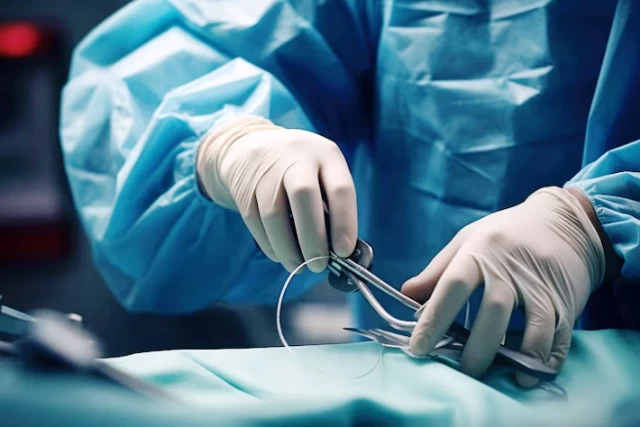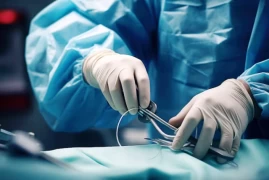
Closed Uterus Removal Surgery (Laparoscopic Hysterectomy)
- Closed Uterus Removal Surgery (Laparoscopic Hysterectomy)
- What is Closed Uterus Removal Surgery?
- Advantages of Closed Uterus Removal Surgery:
- Disadvantages of Closed Uterus Removal Surgery:
- In Which Diseases are Closed Uterus Removal Surgeries Preferred?
- How Does the Process of Closed Uterus Removal Surgery Work?
- What is the Recovery Process After Closed Uterus Removal Surgery Like?
- Are There Risks Associated with Closed Uterus Removal Surgeries?
What is Closed Uterus Removal Surgery?
Closed uterus removal surgery, medically known as laparoscopic hysterectomy, is a surgical procedure performed to remove the uterus and, sometimes, problematic or diseased tissues in the ovaries through small incisions made in the abdominal cavity.
Advantages of Closed Uterus Removal Surgery:
Closed uterus removal surgery offers several advantages compared to the traditional open surgery method. Here are some advantages of closed uterus removal surgery:
- Less invasive: Closed uterus removal surgery is performed through small incisions in the abdominal cavity, avoiding the need for a large incision as in traditional open surgery. A less invasive approach results in smaller incisions, less tissue damage, and reduced blood loss.
- Faster recovery: Surgeries performed using laparoscopic techniques generally lead to a faster recovery process. Smaller incisions and less tissue damage help reduce postoperative pain, allowing patients to move, return to normal activities, and shorten hospital stays more quickly.
- Less pain: Closed uterus removal surgery is generally associated with less pain compared to traditional open surgery. Small incisions and less tissue damage contribute to reducing postoperative pain, providing a more comfortable recovery process for patients.
- Lower infection risk: Closed surgeries typically carry a lower risk of infection. Small incisions decrease the risk of infection and lower the probability of postoperative infection development.
- Cosmetic advantage: When using closed surgical techniques, the incisions are smaller, resulting in more favorable cosmetic outcomes. Postoperative scars may be smaller and less noticeable.
- Quick return to normal activities: Closed uterus removal surgery allows patients to return to their normal daily activities more quickly. They can often be discharged from the hospital within a few days, and the overall recovery process may be shorter.
These advantages have made closed uterus removal surgery a popular option. However, since each patient's situation is unique, the choice of surgery should be determined based on the patient's medical history, the condition of the discomfort, and the evaluations of the doctor.
Disadvantages of Closed Uterus Removal Surgery:
Some disadvantages of closed uterus removal surgery may include:
- Technical challenges: Closed surgeries may be more technically challenging compared to traditional open surgery. Surgeons must work with small incisions that limit access to the abdominal cavity. Therefore, the success of the surgery or the risk of complications may be influenced by an inexperienced or inadequately trained surgeon.
- Limited access: The size and shape of laparoscopic tools used in closed uterus removal surgery may limit the surgeon's ability to remove the uterus and perform other procedures. In some cases, open surgery may be required.
- Prolonged surgery time: Closed surgeries may take longer than traditional open surgery methods. Learning and applying laparoscopic techniques can take time, extending the duration of the surgery.
- Special equipment requirement: Closed uterus removal surgery requires special laparoscopic equipment and surgical tools. The cost of this equipment may be higher, and it may not be fully available in some healthcare facilities.
- Risk of complications: Like any surgical procedure, closed uterus removal surgery carries a potential risk of complications. These complications may include infection, bleeding, urinary tract injury, bowel injury, and wound healing problems.
- Inappropriate conditions: Closed surgery may not be suitable for every patient. Especially for patients with a large uterus size or a history of previous abdominal surgeries, open surgery may be preferred.
These disadvantages should be evaluated based on each patient's condition and surgical needs. The choice of surgery should be determined considering the patient's medical history, the condition of discomfort, and the evaluations of the surgeon. Your doctor will guide you to determine the most suitable option for you.
In Which Diseases are Closed Uterus Removal Surgeries Preferred?
Closed uterus removal surgery may be preferred in various conditions related to the uterus. Here are some disease conditions where closed uterus removal surgery may be considered:
- Uterine fibroids: Uterine fibroids are benign (non-cancerous) tumors in the uterus. Closed uterus removal surgery may be a suitable option depending on the size and location of the fibroids.
- Uterine prolapse: Uterine prolapse occurs when the uterine tissue weakens, resulting in the descent of the uterus in the pelvic region. Closed surgeries may be an option for treating uterine prolapse.
- Chronic pelvic pain: Chronic pelvic pain is a condition characterized by constant or recurrent pain in the pelvic region. Closed uterus removal surgery may be an option if there are issues with the uterus or pelvic structures causing the pain.
- Excessive bleeding: Excessive bleeding during menstrual periods, known as dysfunctional uterine bleeding, may be treated by removing the uterine tissue causing the bleeding.
- Uterine cancer: When diagnosed with uterine cancer, closed uterus removal surgery may be considered among the treatment options. However, open surgery may be required depending on the stage and spread of the cancer.
- Gynecological cancers: Some gynecological cancers, such as ovarian cancer or cervical cancer, may necessitate the removal of the uterus during closed uterus removal surgery.
How Does the Process of Closed Uterus Removal Surgery Work?
Closed uterus removal surgery is typically a surgical procedure performed under general anesthesia. Here is a general overview of how closed uterus removal surgery works:
- Anesthesia: The surgery is usually performed under general anesthesia, meaning you will not be awake during the procedure, and you won't feel any pain.
- Surgical access: The surgeon makes small incisions in the abdominal region. These incisions are used for the insertion of a thin, illuminated tube called a laparoscope and other surgical tools into the abdominal cavity.
- Visualization: The laparoscope, inserted into the abdominal cavity, allows the surgeon to see inside and guide the procedure. It works in conjunction with a video camera, enabling the surgeon to view the surgical area on a screen.
- Organ removal: The surgeon uses appropriate surgical tools to remove the uterus and any diseased or problematic tissues in the ovaries if necessary. This process may involve removing the affected part of the uterus or ovaries.
- Wound closure: Once the surgery is complete, the surgeon carefully closes the incisions. Small incisions are typically closed with stitches or surgical glue.
- Recovery process: The postoperative recovery process can vary from person to person. Patients generally stay in the hospital for a few days, where pain control and monitoring of drainage are provided. Your surgeon will provide instructions for the recovery process, activity adjustments, and any follow-up appointments.
What is the Recovery Process After Closed Uterus Removal Surgery Like?
The recovery process after closed uterus removal surgery can vary from person to person but generally includes the following stages:
- Hospital stay: The postoperative hospital stay is typically between 1 to 2 days. During this time, pain control, monitoring of drainage, and overall health monitoring are provided.
- Pain control: Postoperative pain is normal. Your doctor may prescribe prescription or over-the-counter pain relievers to control pain. Pain levels will decrease over time, and you will feel more comfortable as the recovery process progresses.
- Healing time: The healing time usually ranges from 4 to 6 weeks. During this time, the incisions inside your body will heal, and the process of returning to normal activities will begin.
- Activity adjustments: It is important to rest and focus on recovery for a while after surgery. Your doctor will provide instructions on how long you should avoid heavy lifting, exercise, or sexual activity.
- Wound care: Taking good care of your incisions to reduce the risk of infection is important. Keep the wounds clean and dry to promote healing. Follow your doctor's instructions for wound care, and wait for the stitches to heal properly.
- Follow-up appointments: Regular follow-up appointments will be scheduled during the postoperative period. Your doctor will call you in at specific times to monitor your recovery and detect any complications.
The postoperative recovery process can vary from person to person. Some patients may recover faster, while others may take longer. It is important to support the recovery process by resting, eating healthily, following your doctor's instructions, and immediately reporting any issues to your doctor.
Are There Risks Associated with Closed Uterus Removal Surgeries?
Closed uterus removal surgery, like any surgical procedure, comes with certain risks. Potential complications may include infection, bleeding, wound healing problems, or urinary tract injury. Therefore, it is crucial to thoroughly discuss all risks and benefits with your doctor before the surgery.
Op. Dr. Önder KAPLAN
Obstetrician and Gynecologist




